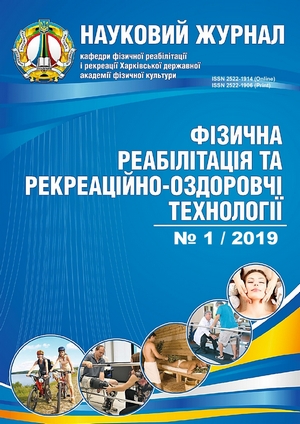Основи визначення оптимального навантаження у процесі фізичної реабілітації школярів з асоціальним типом поведінки
DOI:
https://doi.org/10.15391/prrht.2019-4(1).02Ключові слова:
ндивідуальне дозування, асоціальна поведінка, рухова активність, реабілітація, фізична культураАнотація
Мета: дослідити вікові закономірності адаптації організму школярів різних типів поведінки до фізичного навантаження, експериментально обґрунтувати оптимальну технологію індивідуального їх дозування. Матеріал і методи: для виявлення вікові закономірності адаптації організму школярів різних типів поведінки до фізичного навантаження було проведено тестування 215 учнів у віці від 11 до 17 років шкіл №№ 1, 15, 20 м. Слов’янська Донецької області. Тестування проводились на початку та в кінці дослідження. Учні утворили контрольну групу та експериментальну групу. Результати: за нашими даними школярі у нормі мають перевагу в реалізації рухового потенціалу, а учні «групи ризику» помітно уступають одноліткам у цьому компоненті рухової дії. Висновки: Експериментально доведена перспективність нормування фізичного навантаження за величиною ІНПБ, ніж на основі результатів вимірювання частоти серцевих скорочень під час роботи.
Посилання
Белогуров С.Б. Научно о наркотиках и наркоманах.- М.: СПб.: Невський диалект-Бином, 1998.- 128с.
Важковиховуваність: сутність, причини, реабілітація (Ред.). (2009).Суми.Університетська книга.
Воронцова М. В. (Ред). (2014).Теория деструктивности. Таганрог. Издатель А.Н. Ступин.
Воспитание трудного ребенка. Дети с девиантным поведением(Ред.).(2001).Москва. Гуманит. изд. центр ВЛАДОС.
Вольнова Л. М. (2016). Профілактика девіантної поведінки підлітків: навч.-метод. посібник до спецкурсу «Психологія девіацій» для студентів спеціальності «Соціальна робота» у двох частинах. – Ч. 1. Теоретична частина. – 2-ге вид., перероб і доповн. Київ.
Курек Н.С. (1993) Медико-психологический подход к диагностике повышенного риска заболевания наркоманией у подростков. Вопросы наркологии. № 1. С.54-59.
Ковальчук М. А. (Ред). (2013).Девиантное поведение: профилактика, коррекция, реабилитация. Гуманитар. изд. центр ВЛАДОС.
Котляров А. В. (Ред). (2006). Другие наркотики или Homo Addictus. Москва. «Психотерапия».
Моченова В.П. (1999). Спорт против наркотиков. Физкультура. № 3-4. С.61-63.
Петракова Т.И. (1991). Руководство по профилактике наркомании среди детей и подростков. Москва. Медицина.
Самойлов А. М. (2016) Типи девіантних підлітків. Матеріали V Міжнародної інтернет-конференції молодих учених і студентів. Глухів. РВВ Глухівського НПУ ім. О.Довженка.
Самойлов А. М. (2014). Педагогічний потенціал соціально-культурного середовища школи в системі профілактики девіантної поведінки підлітків. Матеріали ІІ Всеукраїнської конференції молодих учених і студентів. Вінницький державний педагогічний університет імені Михайла Коцюбинського. ТОВ фірма «Планер».
##submission.downloads##
Опубліковано
Версії
- 2023-10-22 (2)
- 2023-10-22 (1)
Номер
Розділ
Ліцензія
Авторське право (c) 2021 А.О. Щелкунов, С.С. Лисенко, В.А. Шульга

Ця робота ліцензується відповідно до Creative Commons Attribution 4.0 International License.

